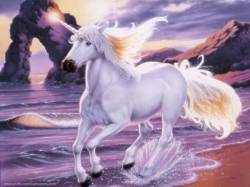
The Unicorn, a legendary animal usually depicted as a large horse with a single horn on its forehead. It has also been described as having the hind legs of an antelope, the tail of a lion, and the beard of a goat. Represented in the arts of numerous ancient and medieval Asian and European cultures, the unicorn may have been created from distorted reports of rhinoceroses. Ctesias, a Greek physician, about 400 BC wrote a classic description of the unicorn, calling it an Indian wild ass with a white body, purple head, and a straight "cubit-long" horn with a white base, black middle, and red tip. He described it as fleet and fierce. The unicorn is also mentioned in the writings of Aristotle, Pliny, and Aelian.
In medieval Christendom the unicorn was endowed with symbolic qualities, both religious and secular. Some early translations of the Hebrew scriptures mentioned the unicorn (modern versions tend to call the same animal a "wild ox"), and as a biblical beast it acquired ecclesiastical associations. It represented chastity and purity. Though it would fight savagely when cornered, it could be tamed by a virgin's touch. Many examples of medieval artincluding woodcuts, illuminations, and tapestriesdepict the unicorn, particularly the hunt for it. In some Christian interpretations the unicorn is associated with the Virgin Mary; in others it represents Christ the Redeemer. Unicorns were also popular emblems in medieval heraldry.
During the Middle Ages, and even later, the unicorn's horn (as it was alleged to be), because of its fabled purity, was a popular ingredient for medicines and for alchemical reactions. Potentates and pontiffs obtained reputed unicorn's horn because it was considered strong protection against poison. The horn was also believed to ward off stomach trouble and epilepsy.
REALMS OF REALITY